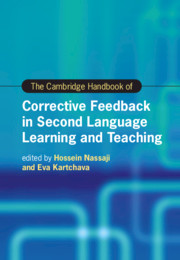Book contents
- The Cambridge Handbook of Corrective Feedback in Second Language Learning and Teaching
- Cambridge Handbooks in Language and Linguistics
- The Cambridge Handbook of Corrective Feedback in Second Language Learning and Teaching
- Copyright page
- Contents
- Figures
- Tables
- Contributors
- Acknowledgments
- Introduction Corrective Feedback in Second Language Teaching and Learning
- Part I Theoretical Perspectives on Corrective Feedback
- Part II Methodological Approaches in the Study of Corrective Feedback
- Part III Different Delivery Modes of Corrective Feedback
- Part IV Feedback Provider, Feedback Intensity, and Feedback Timing
- Part V Corrective Feedback and Language Skills
- 17 Corrective Feedback and the Development of Second Language Grammar
- 18 Corrective Feedback and the Development of Second Language Vocabulary
- 19 Effects of Corrective Feedback on Second Language Pronunciation Development
- 20 Corrective Feedback in Instructional Pragmatics
- 21 Alphabetic Print Literacy Level and Noticing Oral Corrective Feedback in SLA
- Part VI Contexts of Corrective Feedback and Their Effects
- Part VII Learners’ and Teachers’ Feedback Perspectives, Perceptions, and Preferences
- Part VIII Individual Differences, Tasks, and Other Language- and Learner-Related Factors
- Index
- References
21 - Alphabetic Print Literacy Level and Noticing Oral Corrective Feedback in SLA
from Part V - Corrective Feedback and Language Skills
Published online by Cambridge University Press: 26 February 2021
- The Cambridge Handbook of Corrective Feedback in Second Language Learning and Teaching
- Cambridge Handbooks in Language and Linguistics
- The Cambridge Handbook of Corrective Feedback in Second Language Learning and Teaching
- Copyright page
- Contents
- Figures
- Tables
- Contributors
- Acknowledgments
- Introduction Corrective Feedback in Second Language Teaching and Learning
- Part I Theoretical Perspectives on Corrective Feedback
- Part II Methodological Approaches in the Study of Corrective Feedback
- Part III Different Delivery Modes of Corrective Feedback
- Part IV Feedback Provider, Feedback Intensity, and Feedback Timing
- Part V Corrective Feedback and Language Skills
- 17 Corrective Feedback and the Development of Second Language Grammar
- 18 Corrective Feedback and the Development of Second Language Vocabulary
- 19 Effects of Corrective Feedback on Second Language Pronunciation Development
- 20 Corrective Feedback in Instructional Pragmatics
- 21 Alphabetic Print Literacy Level and Noticing Oral Corrective Feedback in SLA
- Part VI Contexts of Corrective Feedback and Their Effects
- Part VII Learners’ and Teachers’ Feedback Perspectives, Perceptions, and Preferences
- Part VIII Individual Differences, Tasks, and Other Language- and Learner-Related Factors
- Index
- References
Summary
Increasingly, large numbers of adult immigrants and refugees who are not alphabetically literate are engaging in SLA and becoming orally multilingual. However, there is good reason to suspect that many theoretical claims about the role of corrective feedback in second language acquisition do not hold for such learners. In particular, the research reviewed in this chapter shows that adult L2 learners who have low levels of alphabetic print literacy do not appear to benefit from oral corrective feedback on form as much as their alphabetically literate counterparts do. These findings suggest that it is alphabetic print literacy that provides learners with language processing tools required for noticing of form-focused corrective feedback. Theoretical claims implying the universal efficacy of oral corrective feedback in SLA must be fine-tuned to reflect the actual learning processes of this growing population of successful L2 learners.
Keywords
- Type
- Chapter
- Information
- The Cambridge Handbook of Corrective Feedback in Second Language Learning and Teaching , pp. 450 - 470Publisher: Cambridge University PressPrint publication year: 2021
References
- 3
- Cited by

